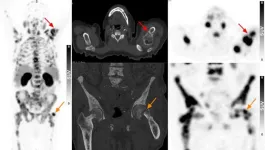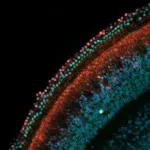(Press-News.org) Key takeaways
In the fast-growing marketplace for recreational marijuana and related products, products containing cannabinoids called HHCs are gaining popularity.
The neurological and physiological effects of HHCs are not well understood.
A new study by UCLA chemists is the first to explain how well HHCs bind to receptors in the human body; the scientists also devised a safer way to produce HHCs than the current standard process.
As more of the nation has adopted legal marijuana, a glut of products has emerged in dispensaries that contain the psychoactive ingredient in marijuana, THC, as well as other cannabinoids that can be derived from THC or the plant itself.
Cannabinoids is the umbrella term for a group of substances that bind with cannabinoid receptors in the body and brain. Some cannabinoids, of course, are found in the cannabis plant, the best known of which is THC. But many of the new products being sold in dispensaries today are made with other classes of cannabinoids whose neurological or physiological effects are not well understood.
That has created a kind of “wild west” in the marijuana marketplace, making it difficult for governments to regulate the new products and develop fair laws regarding their use.
UCLA chemist Neil Garg is one of a group of scientists who are rapidly learning more about emerging cannabinoids. Their goals include ensuring the safety of products being sold to consumers and helping government agencies develop evidence-based laws for the fast-growing industry.
A new paper by Garg and colleagues takes a close look at one class of those emerging cannabinoids: hexahydrocannabinols, or HHCs. The study systematically evaluates how well HHCs bind to receptors in the human body.
“The compounds have been tested in animals before, but the basic binding assays of each isomer were somehow not done or not reported,” said Garg, UCLA’s Kenneth N. Trueblood Professor of Chemistry and Biochemistry, a UCLA distinguished professor and the paper’s senior author. “That is unusual for a product that’s widely available to consumers, and it reflects the need for more fundamental research in this rapidly evolving field.”
HHC products on the market today typically contain a mixture of two different versions, or isomers, of the HHC molecule. In the new study, the scientists found that although both isomers bind to the same cannabinoid receptors in the body as THC does, only one of the isomers binds as well as THC does — which suggests that it is the only HHC isomer with effects comparable to THC.
The paper, published in ACS Chemical Biology, also describes a new method for synthesizing the more biologically active of the two HHC isomers.
Most HHCs found in commercially available products are synthesized from THC by manufacturers using a process called catalytic hydrogenation. The technique produces both isomers of HHC in variable ratios. As a result, there is little consistency in the amount of each HHC isomer in HHC products — not only from one brand to the next but even among batches produced by the same manufacturer. And because the ratios are variable, some HHC products being sold to consumers contain relatively little of the more biologically active isomer.
Garg and Daniel Nasrallah, a UCLA assistant adjunct professor of chemistry, developed a method that relies instead on a chemical process called hydrogen atom transfer. Using their method to produce HHCs yields roughly 10 times more of the biologically active isomer than the less active one.
The new method also is safer than catalytic hydrogenation, a process that uses hydrogen gas, which when not handled carefully can lead to laboratory fires. Labs that use catalytic hydrogenation also often use potentially toxic heavy metals like platinum or palladium as part of the process.
“If a medical drug was being synthesized using these metals, careful analysis would be required to ensure these metals are not present in the final commercial products in order to avoid any toxicity concerns,” Garg said.
Nasrallah said that generally is not happening now. “Typically, HHCs being sold for recreational use are not analyzed for the presence of platinum or palladium,” he said.
Garg said further research on cannabinoids and their effects is essential.
“These studies are crucial if we are to have laws and policies that are fair and allow for consumer safety, while allowing scientists and society alike to explore the potential therapeutical effects of new cannabinoids,” he said.
The paper notes that although there is a popular belief that HHCs are legal under federal law, the U.S. Drug Enforcement Agency considers them illegal.
The new study on HHCs was funded by ElectraTect Inc., a startup company spun out of Garg’s UCLA research, and performed with an appropriate DEA license. Earlier this year, Garg and UCLA collaborators received a $2 million grant from the California Department of Cannabis Control to evaluate new cannabinoids.
END
Consumers who buy cannabis products containing HHCs could be getting less than they hoped for
UCLA chemists develop method for producing a form of the substance that acts more predictably, consistently
2023-08-14
ELSE PRESS RELEASES FROM THIS DATE:
A new way to evaluate the impact of medical research
2023-08-14
Scientific journals and research papers are evaluated by a metric known as their “impact factor,” which is based on how many times a given paper is cited by other papers. However, a new study from MIT and other institutions suggests that this measure does not accurately capture the impact of medical papers on health outcomes for all patients, particularly those in low- or middle-income countries.
To more fully capture a paper’s impact on health, metrics should take into account the demographics of the researchers who performed the ...
Department of Energy announces $112 million for research on computational projects in fusion energy sciences
2023-08-14
WASHINGTON, D.C. - Today, the U.S. Department of Energy’s (DOE) Office of Science (SC), announced $112 million in funding for 12 projects that focus on collaborations among fusion scientists, applied mathematicians, and computer scientists to maximize the use of high performance computing, including exascale computers.
The Scientific Discovery through Advanced Computing (SciDAC) program pairs the Fusion Energy Sciences (FES) program with the Advanced Scientific Computing Research (ASCR) program to explore solving complex ...
Cancer-infecting virus ‘warms up’ cold tumors and improves immunotherapy
2023-08-14
Equipping cancer-infecting, or oncolytic, viruses with tumor-inhibiting genetic cargo stimulates the immune system and helps immunotherapy to shrink or completely clear aggressive tumors in mice, according to a new study in the Journal of Experimental Medicine led by University of Pittsburgh and UPMC researchers. The results pave the way for clinical trials combining oncolytic viruses with immunotherapy.
Oncolytic viruses are genetically modified viruses that target rapidly dividing tumor cells while avoiding normal cells. Oncolytic viruses were originally designed to directly kill cancer cells, but researchers later ...
PSMA PET/CT waives the need for pre-imaging biopsy in elderly patients
2023-08-14
Reston, VA—In elderly patients with suspected prostate cancer, PSMA PET/CT can diagnose advanced disease and aid in therapy selection without the need for a biopsy. Published in the July issue of The Journal of Nuclear Medicine, this new research demonstrates how imaging with PSMA PET/CT can potentially reduce the number of prostate biopsies and associated complications in the elderly while providing accurate staging data.
68Ga-PSMA PET/CT has gained acceptance as a highly sensitive and specific imaging modality for evaluating the extent of disease in prostate cancer patients. In general, PSMA PET/CT is indicated when intermediate ...
How did South African healthcare workers cope during the pandemic?
2023-08-14
A new study by UC Berkeley Anthropology Professor Andrew Wooyoung Kim reveals resilient coping mechanisms used by healthcare workers during the COVID-19 pandemic in metro Johannesburg, South Africa.
Titled “Coping strategies employed by public psychiatric healthcare workers during the COVID-19 pandemic in southern Gauteng, South Africa,”(link is external) Kim's paper was published in PLOS ONE in August. It explores the diverse coping strategies employed by public psychiatric healthcare workers during ...
Scientists outline a new strategy for understanding the origin of life
2023-08-14
Despite decades of progress, the origin of life remains one of the great unsolved problems in science. “The most basic features of biology, that organisms are made of cells, that they pass genetic information through DNA, that they use protein enzymes to run their metabolism, all emerged through specific processes in very early evolutionary history,” says Aaron Goldman, Associate Professor of Biology at Oberlin College. “Understanding how these most basic biological systems first took shape will not only give us greater insight into how life works at the most fundamental level, but what life actually is in the ...
USC Stem Cell studies tune into hearing regeneration
2023-08-14
A deafened adult cannot recover the ability to hear, because the sensory hearing cells of the inner ear don’t regenerate after damage. In two new studies, partially funded by the National Institutes of Health and published in the Proceedings of the National Academy of the Sciences (PNAS), USC Stem Cell scientists explain why this is the case and how we might be able to change it.
“In the non-sensory supporting cells of the inner ear, key genes required for conversion to sensory cells are shut off through a process ...
Government regulation can effectively curb social media dangers
2023-08-14
Government legislation to flag and moderate dangerous content on social media can be effective in reducing harm, even on fast-paced platforms such as X (formerly Twitter) new research shows.
Social media posts such as those that promote terrorism and hate, dangerous challenges that put teen lives at risk, or those that glamorise suicide, pose a significant threat to society. And this harm spreads exponentially, like an infectious disease.
Dr Marian-Andrei Rizoiu from the University of Technology Sydney (UTS) Behavioural Data Science Lab and Philipp J. Schneider from École Polytechnique Fédérale de Lausanne harnessed ...
Digital puzzle games could be good for memory in older adults, study shows
2023-08-14
Older adults who play digital puzzle games have the same memory abilities as people in their 20s, a new study has shown.
The study, from the University of York, also found that adults aged 60 and over who play digital puzzle games had a greater ability to ignore irrelevant distractions, but older adults who played strategy games did not show the same improvements in memory or concentration.
It is known that as humans age, their mental abilities tend to decrease, particularly the ability to remember a number of things at a single time - known as working memory. Working ...
Inoue receives funding for Mason CARES Plus
2023-08-14
Inoue Receives Funding For Mason CARES Plus
Megumi Inoue, Associate Professor, Social Work, received funding for: "Mason CARES Plus."
Mason CARES Plus is an expansion study to Mason CARES that will focus on conducting in-depth focus groups and online semi-structured interviews to assess which specific aspects of the Stress Busting Program (SBP) and the Music and Memory program (M&M) were most (and least) impactful in reducing care partner stress and identify effective strategies to improve care partner engagement with the M&M program among Mason CARES participants.
Preliminary results from the Mason CARES study show a high ...
LAST 30 PRESS RELEASES:
First Editorial of 2026: Resisting AI slop
Joint ground- and space-based observations reveal Saturn-mass rogue planet
Inheritable genetic variant offers protection against blood cancer risk and progression
Pigs settled Pacific islands alongside early human voyagers
A Coral reef’s daily pulse reshapes microbes in surrounding waters
EAST Tokamak experiments exceed plasma density limit, offering new approach to fusion ignition
Groundbreaking discovery reveals Africa’s oldest cremation pyre and complex ritual practices
First breathing ‘lung-on-chip’ developed using genetically identical cells
How people moved pigs across the Pacific
Interaction of climate change and human activity and its impact on plant diversity in Qinghai-Tibet plateau
From addressing uncertainty to national strategy: an interpretation of Professor Lim Siong Guan’s views
Clinical trials on AI language model use in digestive healthcare
Scientists improve robotic visual–inertial trajectory localization accuracy using cross-modal interaction and selection techniques
Correlation between cancer cachexia and immune-related adverse events in HCC
Human adipose tissue: a new source for functional organoids
Metro lines double as freight highways during off-peak hours, Beijing study shows
Biomedical functions and applications of nanomaterials in tumor diagnosis and treatment: perspectives from ophthalmic oncology
3D imaging unveils how passivation improves perovskite solar cell performance
Enriching framework Al sites in 8-membered rings of Cu-SSZ-39 zeolite to enhance low-temperature ammonia selective catalytic reduction performance
AI-powered RNA drug development: a new frontier in therapeutics
Decoupling the HOR enhancement on PtRu: Dynamically matching interfacial water to reaction coordinates
Sulfur isn’t poisonous when it synergistically acts with phosphine in olefins hydroformylation
URI researchers uncover molecular mechanisms behind speciation in corals
Chitin based carbon aerogel offers a cleaner way to store thermal energy
Tracing hidden sources of nitrate pollution in rapidly changing rural urban landscapes
Viruses on plastic pollution may quietly accelerate the spread of antibiotic resistance
Three UH Rainbow Babies & Children’s faculty elected to prestigious American Pediatric Society
Tunnel resilience models unveiled to aid post-earthquake recovery
Satellite communication systems: the future of 5G/6G connectivity
Space computing power networks: a new frontier for satellite technologies
[Press-News.org] Consumers who buy cannabis products containing HHCs could be getting less than they hoped forUCLA chemists develop method for producing a form of the substance that acts more predictably, consistently



